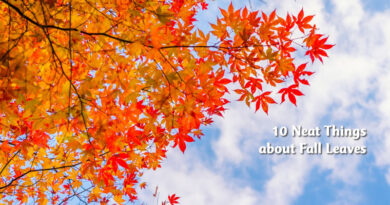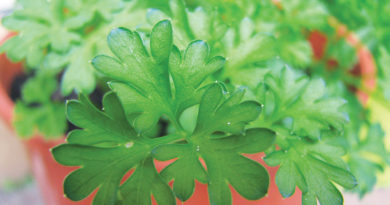Asian Greens
A shrinking globe brought Asian vegetables to prominence in North America. Tourists, soldiers returning from the Korean and Vietnam wars, and Asian immigrants helped introduce North America to new food tastes. The resulting impact of the popularity of Asian greens in the last 25 years in North America has been one of the most significant continental introductory vegetable explosions since early colonization.
Asian greens, generally vegetables and herbs grown for edible leaves and stems, have been cultivated for over 3,000 years. They easily adapt to most North American climatic regions. Their popularity is further enhanced by the plants’ ability to produce multiple crops each season.
Asian green cultivation is very similar to that of North American lettuce in that most of the plants like to be cultivated in cool weather. An advantage, though, is that they do not bolt like lettuce. This permits the gardener to plant two crops in the garden, with seed or seedlings planted in the spring, and seedlings in the late summer to early fall. Gardeners can also maintain a crop through the heat of summer in a medium shade garden where plants are not subjected to direct sunlight.
Beds should be airy and contain much rich vegetative matter like compost or rotted manure. A top dressing of a balanced or nitrogen-leaning fertilizer encourages good leaf development.
The site should never be parched and should receive one to two inches of water each week with morning watering permitting the leaves to air dry and discourage mold.
Asian greens differ from their North American cousins as their leaves are thinner and more prone to suffer damage from pests and diseases. Their main pests are flea beetles, aphids, cabbage worms, rabbits and Harlequin bugs. Most insect and bunny problems can be prevented by placing a floating row cover over the bed, which can remain until the plants have stopped producing.
Some popular varieties include:
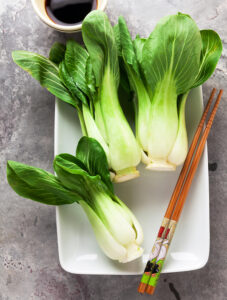
Bok choi. Translated from Chinese this means ‘white vegetable’, and it’s one of the most popular Asian greens. This cabbage-like vegetable reaches two-foot heights and is thought to have been introduced into North America by eastern missionaries in the 19th century. It likes cool weather, fertile, well drained, moist soil, and is high in vitamins A and C. Bok choi, is a member of the cruciferous family and contains sulforaphane, which helps stimulate enzymes that protect against cancer.
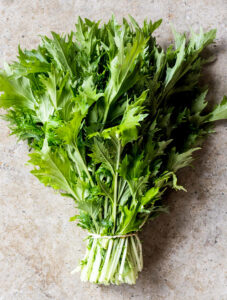
Mizuna is a mild mustard green, Chinese in origin, but considered a Japanese vegetable.
It features serrated leaves and, if clipped properly, can produce continuous harvests.
Mustard greens prefer moderate growing conditions with fertile soil, full sun – early and late season – and shade in the summer. Their shallow roots make them more susceptible to drought and they need to have at least one inch of water each week. Asian mustard greens are not as pungent as Western. Pak choi is one of the favoured varieties.

Malabar spinach, not really a member of the spinach family, tastes remarkably like spinach, is very heat tolerant and rich in vitamin C.
This plant, named after the region of India where it originated, is grown as a vine reaching upwards of 12 feet in northern climates and as high as 30 feet in the tropics. Other names for the plant include Ceylon spinach and Indian spinach. Malabar is used very effectively in agricultural displays at Epcot Centre in Disneyworld.
Malabar should be started indoors and transplanted when temperatures at night are generally above 50 degrees. Plants do not bolt in hot weather, are virtually insect free and have only minor problems with leaf spot. Soil should be well drained and moisture retentive.
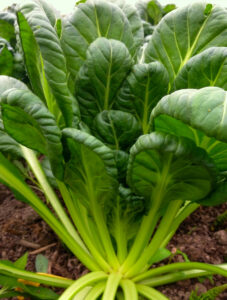
Tatsoi is a compact, sweet-tasting vegetable, approximately one foot high, with small, perfectly round leaves. It is often part of mesclun lettuce mixes and is also known as flat cabbage.
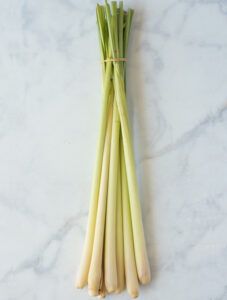
Lemon grass is a tall grass with long, sharp blades. It is native to India, Thailand and other parts of Asia. The plant, not a green in the strictest sense, is considered a green herb and contains citral, a chemical also found in lemon peel, that gives it a lemony scent.
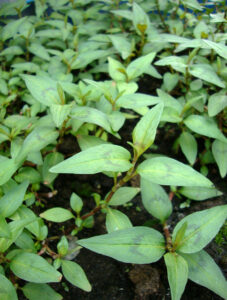
Vietnamese coriander, also known as Vietnamese cilantro, is a hot-weather perennial that dies on freezing. The plant grows rapidly and sometimes needs transplanting twice during the season. Grows best in semi-shade or filtered shade and needs regular watering. It is a tender perennial that can be cultivated indoors if brought in before frost.
Most nurseries and seed companies have responded to the demand for Asian greens with seedlings and seed readily available. Find a little patch in your garden for these uncommon adopted vegetables. Your taste buds will be eternally grateful.
Most nurseries and seed companies have responded to the demand for Asian greens with seedlings and seed readily available. Find a little patch in your garden for these uncommon adopted vegetables. Your taste buds will be eternally grateful.




